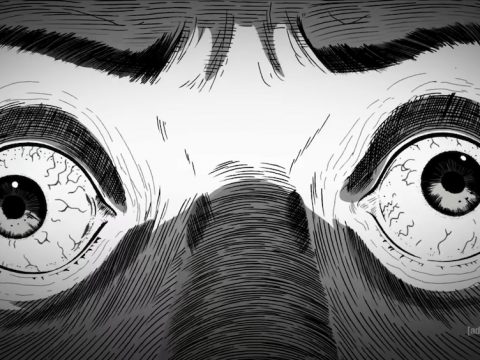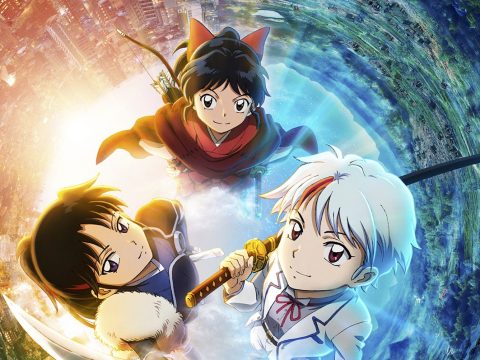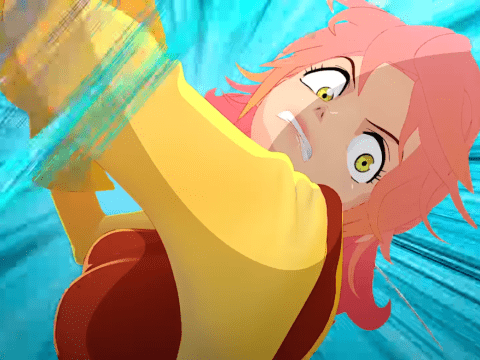Answering The Big Questions

The Big O was like catnip to a certain strain of conspiracy-obsessed anime fans when it premiered on Toonami in the spring of 2001. Composed of a series of design elements that were so recognizable as to be cliché on their own but that together added up to something singular—drawing freely from the neo-noir and expressionist styling of Bruce Timm’s Batman: The Animated Series, the Art Deco movement, and the steampunk-style futurism of giant robot series such as Tetsujin-28 and Giant Robo for its aesthetic, while cribbing with equal aplomb from the stories of Fritz Lang, Isaac Asimov, and Raymond Chandler for its plot—its very existence presented a mystery in need of solving. The show’s structure proved similarly baffling: episodes that began as standard crime procedurals were quick to spiral into a mishmash  of super robot brawls, metaphysical ponderings, and Lynchian discomforts that existed in tensions never quite resolved. Paradigm City was the name given to the stage this all played out on, but given how violently its many disparate elements clashed it might have been more appropriately named Paradox. Nothing about it—to borrow the series’ distinct phrasing—ever seemed to “come to terms.”
of super robot brawls, metaphysical ponderings, and Lynchian discomforts that existed in tensions never quite resolved. Paradigm City was the name given to the stage this all played out on, but given how violently its many disparate elements clashed it might have been more appropriately named Paradox. Nothing about it—to borrow the series’ distinct phrasing—ever seemed to “come to terms.”
But if protagonist Roger Smith could dismiss the enigmas at the series’ heart with his typical candor (“It’s not my job to dig any deeper,” he quipped at the end of the first episode), we could not: the world he inhabited was too singular, too strange to be arbitrary. There had to be some deeper reason it existed. Such disparate elements didn’t collate by accident. Their proximity suggested instead a very deliberate guiding hand, a creator present and curious and active if not necessarily benevolent. And indeed, with each episode it became clearer that there was some intelligent design underlying the series’ patchwork arrangement. Questions piled atop questions, and although we were never told directly what transpired 40 years ago to wipe clean the memories of Paradigm’s citizens, we learned enough about the nature of Memories (which, ambiguous as they were, seemed to stand for all mysteries) that we began to construct some idea of the bigger picture.
Never a full idea, of course, nor a clear one. Any glimpse of the truth director Kazuyoshi Katayama and head writer Chiaki J. Konaka allowed was only through a glass darkly and from an obscure angle that distorted our view so we could never be certain what patterns we were seeing, if in fact these patterns had not been  imposed by our imagination into something formless. But what we could make out looked too much like something for us to dismiss it as our own invention. By the time the 13th episode aired, we seemed on the brink of some great revelation. Vivid hallucinations revealed that Roger’s relationship with the Big O was the result of a memory replication experiment carried out by Gordon Rosewater, the city’s founder. A mysterious book and apocalyptic visions showed that the world had ended, as many eager theorists had guessed, in nuclear fire lobbed by legions of Megadeuses.
imposed by our imagination into something formless. But what we could make out looked too much like something for us to dismiss it as our own invention. By the time the 13th episode aired, we seemed on the brink of some great revelation. Vivid hallucinations revealed that Roger’s relationship with the Big O was the result of a memory replication experiment carried out by Gordon Rosewater, the city’s founder. A mysterious book and apocalyptic visions showed that the world had ended, as many eager theorists had guessed, in nuclear fire lobbed by legions of Megadeuses.
Only the climactic conversation between Roger and Gordon that promised to answer everything fizzled in a non-explanation. “The world destroyed by a cataclysm. The giant robots that ran rampant. The power of God wielded by man.… It’s all lies,” the man rumored to know the true history of the world said with a dismissive chuckle. No sooner had we been proffered an answer than we were denied it. The fatal showdown with a Dorothy look-alike ended in similar ambiguity. Before Roger could glean who’d sent her or why he was drawn into a battle with a trio of mysterious robots. And then the season ended. There was no new episode awaiting us the next night, no answers to any of the million new questions we had. Interviews dug up by the Japanese-fluent revealed there might never be: Sunrise had no plans to make a second season. In the days and weeks to come, Gordon’s laughing dismissal came to sound more and more like the creators’ own.

When, 21/2 years later, the long-awaited second season concluded, the sense of déjà vu was unmistakable. For the better part of that cour the patient fans had seen answers to questions they’d debated finally taking shape: the origins of the murderous R-D, the sweep of Alex Rosewater’s plot, the true nature of Angel’s parent organization the Union, the very nature of Memories (sic): each of these we learned in turn, and in so straightforward a way that it felt inevitable that this time the final episode really would answer every question. But it didn’t. Again, senile Gordon Rosewater broke his act long enough to dismiss our certainty with the reveal that the world 40 years prior had not ended in some cataclysm. In fact, it had never existed! Fire from the heavens dispersed the perpetual fog surrounding Paradigm to unveil not the answers we hoped for, only row after row of mammoth floodlights shining down on the city as if to illuminate a massive stage. Before we’d even had a chance to grasp what we’d seen, a fourth Big—dubbed Big Venus and piloted by Angel—emerged and reset the universe, taking us back to a lightly modified version of the series’ very first scene.
 Accusations and speculation flew immediately, though this time the audience forewent the difficult work of interpretation in favor of casting blame. There was a third season in the wings, the more hopeful said, while the more cynical insisted Katayama and Konaka’s work had seemed nonsensical from the first because it was nonsensical from the first. If at root an apocalypse is supposed to wipe away the current world by unveiling a truth about it so great that the status quo cannot maintain—the word translates from the ancient Greek as “an uncovering,” after all, and is inextricably linked with the word “revelation”—then what Big Venus’s grand reset had uncovered was the series’ ultimate shapelessness, a shapelessness that could do little but collapse under the vast weight of the mysteries it’d piled atop itself.
Accusations and speculation flew immediately, though this time the audience forewent the difficult work of interpretation in favor of casting blame. There was a third season in the wings, the more hopeful said, while the more cynical insisted Katayama and Konaka’s work had seemed nonsensical from the first because it was nonsensical from the first. If at root an apocalypse is supposed to wipe away the current world by unveiling a truth about it so great that the status quo cannot maintain—the word translates from the ancient Greek as “an uncovering,” after all, and is inextricably linked with the word “revelation”—then what Big Venus’s grand reset had uncovered was the series’ ultimate shapelessness, a shapelessness that could do little but collapse under the vast weight of the mysteries it’d piled atop itself.
Had it been any other story, those accusations might ring truer. After all, it’s not uncommon for lazy artists to load their work with abstruse symbols and a plenitude of nonsensical plot threads in the hopes of giving it the air of the mysterious. Creators like J.J. Abrams have made careers out of spinning these kinds of obscurantist wheels and peddling storytelling constructions like the “mystery box.” Series like Attack on Titan and Tokyo Ghoul pile question upon question that, when answered, only give rise to further questions, each one compounding on the last to draw us on in a desperate attempt to hold our attention. What matters in these stories is not necessarily what these answers reveal or what the story reveals to us about our world, only that these reveals should compel viewers to follow along. In such a system all enigmas boil down to the same question with the same answer: Why am I watching? To keep watching.
 In some ways it’s easy to see why the audience would find The Big O’s ending to be disingenuous at best and cynical at worst. After all, while we inevitably sympathized with Roger, the dashing and charming hero, we were subtly set up to identify in method and philosophy with no character so much as the deformed monomaniac Schwarzwald. It was not Roger who pursued the truth of the world, after all. No. In fact, throughout the entire first season Roger balks at the idea of digging deeper, while he spends the second season fervently denying the pull of his Memories (sic) and their implication that his identity might be nothing more than an inherited one. Schwarzwald is not so timid. “My purpose in this world is knowledge, and the dissemination of it,” he proclaims again and again. In fact, the very first words we hear from him—a disembodied growl waxing philosophical over the image of a ruined tunnel leading into complete darkness—seem meant to chide Roger: “Fear comes from not knowing.… (A man) averts his eyes from that fear and acts as if he never had any memories of his life, of his history, from the very beginning.”
In some ways it’s easy to see why the audience would find The Big O’s ending to be disingenuous at best and cynical at worst. After all, while we inevitably sympathized with Roger, the dashing and charming hero, we were subtly set up to identify in method and philosophy with no character so much as the deformed monomaniac Schwarzwald. It was not Roger who pursued the truth of the world, after all. No. In fact, throughout the entire first season Roger balks at the idea of digging deeper, while he spends the second season fervently denying the pull of his Memories (sic) and their implication that his identity might be nothing more than an inherited one. Schwarzwald is not so timid. “My purpose in this world is knowledge, and the dissemination of it,” he proclaims again and again. In fact, the very first words we hear from him—a disembodied growl waxing philosophical over the image of a ruined tunnel leading into complete darkness—seem meant to chide Roger: “Fear comes from not knowing.… (A man) averts his eyes from that fear and acts as if he never had any memories of his life, of his history, from the very beginning.”
Yet despite all this, it is Roger’s philosophy, not Schwarzwald’s, that triumphs both narratively and thematically. For his pain, for his single-minded devotion, the latter is assimilated by his Megadeus. It is the former [by his own confession a man unable to “commit to one truth” and without “the slightest clue who (he) is”] who finds in his uncertainty a freedom that spares him the monomania that consumes then destroys people like Alan, Alex, Schwarzwald, and Vera. A freedom that in turn inspires Angel to reset rather than eradicate Paradigm City. Roger survives in this world of mystery precisely because he is open to the possibilities and contradictions that seem to make up its very fabric. It ultimately matters little to him who he was because he understands that mysteries are not something to be solved because they cannot be solved. They are, as Gordon says, “unreliable,” prone to “degenerate”; one can never be certain what their original form was, if they even ever had such a thing.

And if they did, would that change anything? To arrive at an answer is to strip the world of its wonder, to force one possible conclusion, to deny ourselves of the inexplicable but self-affirming ability to “stand in the rain without an umbrella,” as Roger has it. At some point we have to acknowledge that what drives us forward is not the possibility of answers but precisely the impossibility of them. The world we live in now provides too much of the former: any snake-oil salesman sophisticated enough can find evidence to hock us whatever. In such a climate we are denied the joys of ambiguity, the wonder that comes when we come up against the ineffable. We find minor satisfaction as we connect the dots of one seemingly impossible whodunnit after another but then wonder why the answers they parcel up never satisfy us.
 But it is precisely because we need the unknown now that they disappoint us, precisely why a concept like J.J. Abrams’s “mystery box” will never satisfy. Though it promises mystery, in fact, all it ever delivers—all it can deliver by its very design—is a fatiguing procession of answers destined to end in disappointment. True mysteries, by their very design, put us in contact with the ineffable and the mystical: they outright defy explanation, just as, ultimately, so much of The Big O does. No, the seemingly disparate elements that compose the show never do “come to terms,” but they are not designed to. Just as there was never any plan or necessity for a third season. Would The Big O remain in memory 16 years on if it had offered pat explanations in place of its every puzzle? Would debates about its intent still be raging? Almost certainly not. By presenting and structuring their work as a mystery unto itself, Katayama and Konaka left behind a monument to the power and the beauty of the enigma.
But it is precisely because we need the unknown now that they disappoint us, precisely why a concept like J.J. Abrams’s “mystery box” will never satisfy. Though it promises mystery, in fact, all it ever delivers—all it can deliver by its very design—is a fatiguing procession of answers destined to end in disappointment. True mysteries, by their very design, put us in contact with the ineffable and the mystical: they outright defy explanation, just as, ultimately, so much of The Big O does. No, the seemingly disparate elements that compose the show never do “come to terms,” but they are not designed to. Just as there was never any plan or necessity for a third season. Would The Big O remain in memory 16 years on if it had offered pat explanations in place of its every puzzle? Would debates about its intent still be raging? Almost certainly not. By presenting and structuring their work as a mystery unto itself, Katayama and Konaka left behind a monument to the power and the beauty of the enigma.
The Big O is available on home video from Sentai Filmworks.
This story appears in the Fall 2017 issue of Anime USA Magazine. Click here to get a print copy.







